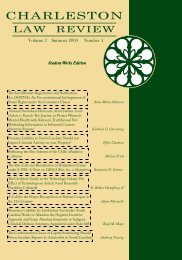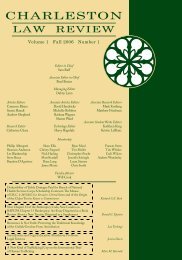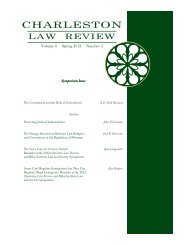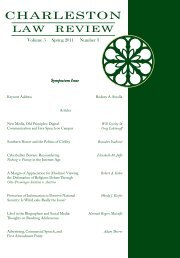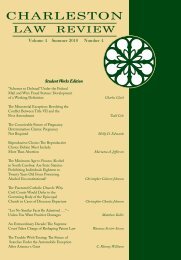Volume 5 Winter 2011 Number 2 - Charleston Law Review
Volume 5 Winter 2011 Number 2 - Charleston Law Review
Volume 5 Winter 2011 Number 2 - Charleston Law Review
Create successful ePaper yourself
Turn your PDF publications into a flip-book with our unique Google optimized e-Paper software.
<strong>2011</strong>] Learning Stylesinteract with and respond to the learning environment and howthey perceive, process, store, and recall what they are attemptingto learn.” 9This Article introduces some of the controversy surroundinglearning styles and considers the implications for legaleducation. 10 Its aim is to contribute to the discussion regardinglegal education and to raise questions regarding whether lawprofessors should embrace the whole-scale use of learning styleassessments and specific classroom interventions to teach tostudents’ self-reported styles. Part I of this Article offers anintroduction to the diversity of learning style theories, withparticular emphasis on those that appear most frequently inlegal education scholarship. Part II explores the criticismaddressed to learning style theories generally, and to theresearch that purports to suggest a positive correlation betweenteaching to students’ individual learning styles and learningoutcomes. Part III discusses the implications of that criticism forlegal education and examines the extent to which thinking aboutlearning styles can help instructors improve their teaching.9. M. H. Sam Jacobson, A Primer on Learning Styles: Reaching EveryStudent, 25 SEATTLE U. L. REV. 139, 142 (2001) [hereinafter Jacobson, A Primeron Learning Styles]. No single definition of learning styles exists, but theconcept embraces the notion that students have a diversity of predilections orapproaches for learning new material.10. The aim of this Article is not to conduct a comprehensive literaturereview or to produce a treatise on learning style theories; experts in variousfields have already done so. See, e.g., Frank Coffield et al., Should We Be UsingLearning Styles? What Research Has to Say to Practice, LEARNING &SKILLS RES.CENTRE (2004), available at https://crm.lsnlearning.org.uk/user/order.aspx?code=041540 (follow the “Download now” hyperlink; then follow the “Downloadwithout registering” hyperlink) [hereinafter Coffield, Should We Be UsingLearning Styles?] (examining the reliability and validity of thirteen learningstyles models); Frank Coffield et al., Learning Styles and Pedagogy in Post-16Learning: A Systematic and Critical <strong>Review</strong>, LEARNING &SKILLS RES. CENTRE(2004), available at https://crm.lsnlearning.org.uk/user/order.aspx?code=041543(follow the “Download now” hyperlink; then follow the “Download withoutregistering” hyperlink) [hereinafter Coffield, Learning Styles and Pedagogy inPost-16 Learning] (examining the pedagogical implications for learning stylestheories in higher education); Harold Pashler et al., Learning Styles: Conceptsand Evidence, 9 PSYCHOL. SCI. IN THE PUB. INT. 105 (2009) (analyzing whethereducational practices built around learning styles assessments are supported byscientific evidence); Jacobson, A Primer on Learning Styles, supra note 9(summarizing the main learning style theories).137



